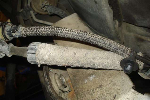96eb96
Explorer Addict
- Joined
- October 20, 2004
- Messages
- 3,524
- Reaction score
- 323
- City, State
- Albany, NY
- Year, Model & Trim Level
- 96 EB V6 OHV 4WD
From my understanding the PCM is in an "open loop"? (or closed loop - not sure) when the engine is warming up and during this time the PCM is not reading the O2 sensors and using stored parameters. This may just explain why the idle is fine while it is warming up at 1000rpm's and then when it warms up and the O2 sensors kick in, they malfunction - causing the stumble. I may have a defective O2 sensor. Thanks for the insight.
This is what a "real diagnostic" is, rather than a shadetree who just reads codes and flips parts. A real datastream with all the ford data shows many little pieces of info that could help solve issues.










